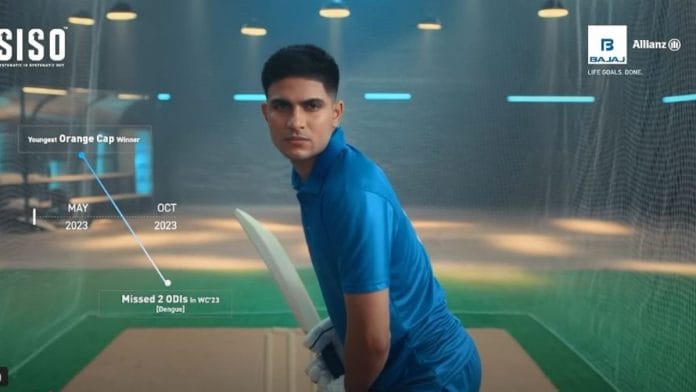Bajaj Allianz Life Insurance’s new campaign featuring its brand ambassador and Indian cricket captain, Shubman Gill, shows him narrating his own journey, marked by both highs and lows, from clinching the Orange Cap in the IPL to sitting out matches.
The Systematic In, Systematic Out ad film draws a parallel between the resilience needed in cricket and the discipline required in long-term financial planning. With this, the central message is: consistent effort, whether on the field or in managing finances, is key to achieving life’s larger goals.
But the question is, does it really make sense for a cricketer to endorse an insurance product? According to India’s renowned PR and communication strategist Dilip Cherian, the answer is no.
“Gill selling insurance is a bad choice. It’s a poor attempt to grab eyeballs,” he said. “After actors, it’s now the cricketers who are suffering from an overload of brand associations. Their credibility will eventually take a hit.”
Experts in the industry also say that for a young Gen Z player like Shubman Gill, talking about investments, mutual funds, or life’s ups and downs doesn’t quite land. Given his age and limited experience—both financial and emotional—his advice on long-term planning feels premature and hard to relate to.
Athletes turning into brand ambassadors
The 1990s marked a turning point in Indian advertising, as cricketers became ad icons. This shift coincided with an explosion in cricket’s popularity in the country. The 1996 Cricket World Cup acted as a major catalyst — transforming cricket into a national obsession and players into household names.
“Brands soon realised that, apart from Bollywood, cricket was the country’s other dominant religion,” Cherian pointed out. “Back then, actors were already overbooked, so roping in cricketers was a fresh and effective strategy.”
Today, as per Cherain, brands prefer making a cricketer their brand ambassador over Amitabh Bachchan or Shah Rukh Khan.
Neha Bajaj, founder of the branding and PR firm Scroll Mantra, highlighted how Sachin Tendulkar’s meteoric rise in the early 1990s made him the ideal face for brands seeking credibility and mass appeal. He quickly became synonymous with iconic names like Boost, MRF, and Pepsi — brands that wanted to connect with India’s aspirational middle class.
“By the early 2000s, MS Dhoni’s personality and growing popularity gave him massive brand value. His associations with brands like TVS and Gulf Oil reflected this appeal,” she added. His World Cup victories also added to his brand.
Later, the launch of the Indian Premier League (IPL) added rocket fuel to this equation. With its unprecedented visibility and mass reach, the IPL became a marketing goldmine for brands.
It also leveled the playing field. Newcomers, once sidelined in brand endorsements, suddenly found themselves in the spotlight.
“Young talents like Ruturaj Gaikwad and Shubman Gill have leveraged their IPL performance to not just break into the international scene but also to cement strong personal brands,” Bajaj explained.
“With massive social media followings and rising fan bases, these cricketers are fast becoming the new favourites for advertisers.”
Also read: Flipkart hasn’t learned from past mistakes. New ad uses a poor, paralysed man as punchline
From Sachin to Shubman
While millennials grew up idolising cricket stalwarts like Sachin Tendulkar and Rahul Dravid, Gen Z loved Virat Kohli and MS Dhoni for their aggressive and cool approach, respectively.
Bajaj noted that as consumer behaviour has evolved, brands have pivoted their strategies accordingly — treating cricketers as not just endorsers but cultural influencers.
“Cricketers today are not just selling products; they are shaping trends and conversations across digital and social platforms,” she said. “While Tendulkar embodied trust and humility, Virat Kohli ushered in an era of boldness, aspiration, and fitness. His partnerships with Puma, Audi, and Too Yumm were firmly rooted in youth culture and performance.”
Dhoni, on the other hand, retained a down-to-earth, all-India charm, making his collaborations with Bharat Cement, Indigo Paints, and Dream11 feel authentic and relevant. And now, the spotlight is on Shubman Gill. Currently the face of 19 brands — including Casio India, Bajaj Allianz Life, TATA Capital, beatXP, ITC Engage, CEAT, Gillette, Nike Sports, and JBL Electronics — Gill is quickly becoming advertising’s new poster boy.
However, this surge in endorsements brings with it a different challenge: a smarter, more skeptical audience.
“Consumers today are more informed and discerning,” Bajaj said. “Endorsing a brand isn’t just about visibility anymore. It’s also about maintaining credibility and managing public perception.”
She stressed that too many endorsements across unrelated sectors can lead to confusion and dilute a celebrity’s authenticity.
“For example, Dhoni endorsing cement aligns perfectly with his image of strength and reliability. But when a cricketer moves from promoting sugary drinks to financial products without a clear narrative, it sends mixed signals,” she explained.
Cherian summed it up with an analogy: “Too many cooks spoil the broth.”
“When too many cricketers feature in ads, or when a single cricketer promotes too many products, it overwhelms and ultimately confuses the audience. The impact and purpose of getting a cricketer as a brand ambassador gets lost,” he said.
Credits:
Brand: Bajaj Allianz Life Insurance
Agency: In-House
Chief Marketing Officer: Chandramohan Mehra
(Edited by Ratan Priya)






